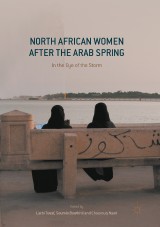Details

North African Women after the Arab Spring
In the Eye of the Storm|
117,69 € |
|
| Verlag: | Palgrave Macmillan |
| Format: | |
| Veröffentl.: | 21.06.2017 |
| ISBN/EAN: | 9783319499260 |
| Sprache: | englisch |
Dieses eBook enthält ein Wasserzeichen.
Beschreibungen
This book looks with hindsight at the Arab Spring and sheds light on the debates it triggered within North African societies and the alarming developments in women’s rights. Although women played a key role in the success of the uprisings that wiped out long ruling oligarchies across the region, they remain excluded from decision-making circles and the formal political and electoral apparatus. Women's rights are written off constitution drafts, and issues of gender equality are hardly addressed. The chapters that compose this volume present research and reflections from different perspectives to help the reader get a better picture of the profound turmoil that beset this part of the so-called “Arab” World. Adopting an interdisciplinary perspective, the contributors discuss a host of questions related to women and gender in the Arab world and address the broader question of why women's efforts and momentum during the revolution did not seem to pay off the same way they did for men. Thisbook provides an assessment of the situation from the inside. It is intended to help the general public as well as the academic world comprehend the significance of what is going on in this key part of the Islamic World.
1. Introduction .- 2. Post-2011 Pressures For Expanded Female Citizenship And Family Law Reform In Mena: Theorizing On Change Amidst Political Transition .- 3. The Liberating Force Of Art, Humor And Social Media: Women Cartoonists Of The Arab Spring .- 4. The Arab Spring And Women’s Rights Activism On Facebook .- 5. Watered-down Feminism: An Examination of Gender And Revolutionary Ideals In Morocco .- 6. “Tradition And Modernity” Or The Ambivalent Public Sphere: Women’s Political Participation In Morocco Before And After The Arab Spring .- 7. Who’s Under The Robe? On Women In The Judicial System In Morocco .- 8. The Women’s Movement And The 20 February Movement In Morocco: An Awkward Relationship .- 9. Mediated Femininity And Female Citizenship In Moroccan Electronic News Sites–Hespress.com As A Case Study .- 10. The Reform Of The Moroccan Family Law And Women’s Daily Life: Navigating Between Structural Constraints And Personal Agency .- 11. Winds Of Change: Egypt’s Islamic Family Law Between Two Centuries (1920-2013) .- 12. Women In Libya: The Ongoing Armed Conflict, Political Instability and Radicalization.
<div><div><b>Larbi Touaf</b> is Associate Professor of English and Gender Studies, and former Chair of the English Department at Mohammed I University, Oujda, Morocco. His research explores the intersections of culture, politics, and literature.</div><div><br></div><div><b>Soumia Boutkhil</b> is Associate Professor of English and Gender Studies at Mohammed I University, Oujda, Morocco. Her research focuses on feminine literature and women’s status in Morocco, particularly on the problematic intersections of law and religion.</div><div><br></div><div><b>Chourouq Nasri </b>is Associate Professor of English, Media and Gender Studies at Mohamed I University, Morocco. Her research and publications explore the interaction of visual culture, gender, and public space.</div></div><div><br></div>
This book looks with hindsight at the Arab Spring and sheds light on the debates it triggered within North African societies and the alarming developments in women’s rights. Although women played a key role in the success of the uprisings that wiped out long ruling oligarchies across the region, they remain excluded from decision-making circles and the formal political and electoral apparatus. Women's rights are written off constitution drafts, and issues of gender equality are hardly addressed. The chapters that compose this volume present research and reflections from different perspectives to help the reader get a better picture of the profound turmoil that beset this part of the so-called “Arab” World. Adopting an interdisciplinary perspective, the contributors discuss a host of questions related to women and gender in the Arab world and address the broader question of why women's efforts and momentum during the revolution did not seem to pay off the same way they did for men. Thisbook provides an assessment of the situation from the inside. It is intended to help the general public as well as the academic world comprehend the significance of what is going on in this key part of the Islamic World.
Considers women's rights in North Africa from different intellectual and practical perspectives Contributes to the international conversation about the gendered consequences of the Arab Spring Deepens readers' comprehension of why women's rights are the battleground for societal change in Islamic culture(s)
“A great book full of important information for those of us who are eager to know about women’s situation in the aftermath of Arab Spring in the MENA region. The book is a must-read for anyone interested in learning about Arab women’s rights from a variety of perspectives and comparative insights across a wide range of disciplines.“ (Touria Khannous, Associate Professor, Department of Foreign Languages and Literatures, Louisiana State University, USA)<p></p>
Diese Produkte könnten Sie auch interessieren:

Inclusión educativa de niños, niñas y adolescentes migrantes venezolanos, en Colombia

von: Douglas Jiménez

15,99 €
















